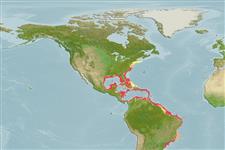>
Eupercaria/misc (Various families in series Eupercaria) >
Lutjanidae (Snappers) > Lutjaninae
Etymology: Lutjanus: Malay, ikan lutjan, name of a fish.
More on author: Cuvier.
Environment: milieu / climate zone / depth range / distribution range
Ecologia
marinhas; estuarina associadas(os) a recifes; intervalo de profundidade 25 - 95 m (Ref. 9626), usually 40 - 70 m (Ref. 9626). Tropical; 20°C - 28°C; 42°N - 28°S, 98°W - 31°W (Ref. 55226)
Western Atlantic: Massachusetts, USA and Bermuda (Anderson, pers. comm.) to southeastern Brazil, including the Caribbean Sea and the Gulf of Mexico (Ref. 9626). Most abundant around the Antilles, the Bahamas and off southern Florida.
Comprimento de primeira maturação / Tamanho / Peso / Idade
Maturity: Lm 43.8, range 28 - 40 cm
Max length : 94.0 cm TL macho/indeterminado; (Ref. 40637); common length : 50.0 cm TL macho/indeterminado; (Ref. 55); peso máx. publicado: 15.6 kg (Ref. 26340); idade máx. registrada: 29 anos (Ref. 46200)
Espinhos dorsais (total) : 10 - 11; Raios dorsais (total) : 13 - 14; Espinhos anais: 3; Raios anais : 7 - 8. Preopercular notch and knob weak. Pectoral fins are long, reaching level of anus. Scale rows on back rising obliquely above lateral line. Back and upper sides olive green, whitish with a red tinge on lower sides and belly. A black spot is on the upper back just above the lateral line and below the anterior dorsal fin rays. A pair of blue stripes runs on the snout-cheek region, the upper continuing behind eye to upper opercle edge.
Adults occur in continental shelf areas as well as clear waters around islands (Ref. 5217). Large adults usually among rocks and coral while juveniles occur over sandy, vegetated (usually Thalassia) bottoms (Ref. 5217). They form small aggregations which disband during the night (Ref. 55). Feed both day and night on fishes, shrimps, crabs, cephalopods, and gastropods (Ref. 55). Flesh considered good quality (Ref. 55). Marketed mainly fresh or frozen (Ref. 55). Traded as an aquarium fish at Clara, Brazil (Ref. 49392).
Ciclo de vida ou comportamento de acasalamento
Maturidade | Reprodução | Desova | Ovos | Fecundidade | Larvas
Allen, G.R., 1985. FAO Species Catalogue. Vol. 6. Snappers of the world. An annotated and illustrated catalogue of lutjanid species known to date. FAO Fish. Synop. 125(6):208 p. Rome: FAO. (Ref. 55)
Status na Lista Vermelha da UICN (Ref. 130435: Version 2024-2)
Ameaça para os humanos
Reports of ciguatera poisoning (Ref. 30303)
Uso pelos humanos
Pescarias: altamente comercial; peixe esportivo: sim; Aquário: Espécies comerciais
Ferramentas
Relatórios especiais
Baixar XML
Fontes da internet
Estimates based on models
Preferred temperature (Ref.
123201): 19.2 - 27.3, mean 24.2 °C (based on 116 cells).
Índice de diversidade filogenética (Ref.
82804): PD
50 = 0.5000 [Uniqueness, from 0.5 = low to 2.0 = high].
Bayesian length-weight: a=0.01380 (0.01248 - 0.01527), b=2.96 (2.94 - 2.98), in cm total length, based on LWR estimates for this species (Ref.
93245).
Nível Trófico (Ref.
69278): 3.9 ±0.2 se; based on diet studies.
Generation time: 7.2 (6.5 - 10.6) years. Estimated as median ln(3)/K based on 12
growth studies.
Resiliência (Ref.
120179): médio(a), tempo mínimo de duplicação da população 1,4 - 4,4 anos (K=0.13-0.25; tm=5.5; tmax=14).
Prior r = 0.36, 95% CL = 0.23 - 0.53, Based on 2 full stock assessments.
Fishing Vulnerability (Ref.
59153): High vulnerability (55 of 100).
Nutrients (Ref.
124155): Calcium = 21.2 [13.4, 30.4] mg/100g; Iron = 0.272 [0.176, 0.416] mg/100g; Protein = 18.8 [17.4, 20.1] %; Omega3 = 0.132 [0.097, 0.176] g/100g; Selenium = 73.1 [47.5, 107.3] μg/100g; VitaminA = 99.9 [18.4, 354.4] μg/100g; Zinc = 0.443 [0.357, 0.594] mg/100g (wet weight);
